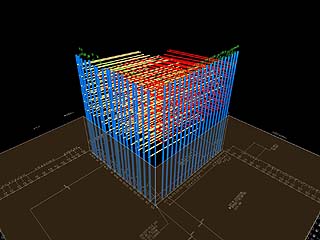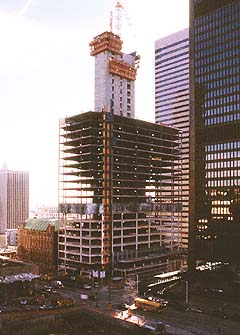 |
October 3, 2002
Uncommon site poses steep challenges
SWMB

Courtesy of SWMB The YMCA building that sits on the corner of the IDX site posed a challenge for the shoring system. Skilling engineers developed a 3D computer model of the tieback anchors to review the site’s complex geometry. |
IDX tower is a notable newcomer to the ever-changing Seattle skyline, introducing both a significant silhouette and an advanced structural system.
The 40-story, 846,588-square-foot office tower is the eighth largest in Washington and, at 512 feet, the first to top the 500-foot height mark in Seattle in over a decade (the last was the 722-foot AT&T Gateway Tower — now called Key Tower — in 1990).
As is typical of many sites in crowded downtown Seattle, the IDX location presented its own set of challenges.
The site is steeply sloping, with an elevation change of 41 feet between the main entries off Fourth and Third avenues. It lies between the Burlington Northern Santa Fe railroad tunnel and the Seattle Metro bus tunnel, both of which are quite sensitive to disruption of their geotechnical environment.
The project also wraps around the historic 1930 downtown YMCA building and had to contend with many existing underground utilities and other site conditions.
The art of shoring
The first challenge began below-grade — way below grade. The shoring excavation for the project was at places 97 feet deep, one of the deepest in Seattle. It was critical that the excavation and placement of the shoring system be carefully coordinated with the rail and bus tunnels, to avoid damage and ensure continuous operation.
The shoring around the base of the YMCA protrudes back into the site as a “reentrant corner.” Such a configuration is relatively uncommon, with system performance made more critical by the size, construction and historic nature of the Y.
A complete 3D computer model of the interfingered shoring tieback anchors in this area was developed to review the complex geometry. With so many tiebacks interacting at this reentrant corner, the 3D model provided a means to eliminate potential location conflicts. The successful underpinning of the Y provided a means to capture valuable real estate and build IDX immediately adjacent to the historic structure.
The shoring system was put to the test when the Nisqually earthquake hit. With excavation at a depth of 60 feet to 70 feet, the system proved itself when no damage was sustained, and the soil stayed where it should.
Taming concrete for the pour
Once the shoring system was in place, the next step was to pour the crucial concrete foundation mat. The mat, measuring 237 feet by 119 feet, ranges from 6 feet to 14 feet in thickness. The 10,952-cubic-yard mat pour took place flawlessly over an uninterrupted 12-hour period.
When pouring such a large mat, careful consideration must be given to prevent collapse of the rebar reinforcement under the force of the incoming concrete, which would destroy the mat. A normal approach of using rebar “standees” was not sufficient.
Instead, a system of supports was designed that configured the reinforcing bar in a three-dimensional matrix, in effect turning the rebar into a very large space truss. Designed for the loads from the placement equipment and workers, and reviewed for the hydrodynamic forces resulting from the concrete placement, the system functioned perfectly and proved very cost-effective.
Advancing earthquake design
Moving upward, the building significantly advances the state of the art in earthquake engineering through the use of a performance-based design concept for the concrete shear wall core. The core walls rise 553 feet above the 14-foot thick portion of the concrete mat foundation. The light, efficient core works in combination with the massive mat foundation to provide a safe building.

Photo by Michael Dickter/SWMB Engineers used a performance-based approach to design the IDX Tower’s shear wall core and frame, removing the need for bulky extras like diagonal steel bracing and an exterior moment frame.
|
A building of this size would traditionally require dual “lateral” (i.e., earthquake-resisting) systems in order to meet the Seattle building code. A similar design, not performance-based, could, for example, employ very large columns and diagonal steel bracing combined with a costly, intrusive, and view-obstructing exterior moment frame.
The design of IDX Tower ensures that the lateral system meets the performance objectives of the building code by more accurately analyzing the performance of the building under an earthquake loading in excess of the requirements of the building code.
The resulting design produces a highly efficient and safe structure. The system also maximizes value for the project by taking less space in plan and elevation and enhances occupant comfort in windy conditions.
Additionally, stringent steel reinforcement detailing requirements significantly enhance the performance of the structure in the event of large earthquake ground motions.
The elimination of the exterior lateral frame provides long spans of glass with spectacular views of Mount Rainier, Puget Sound and the Olympic Mountains. The lack of large exterior columns provides maximum flexibility for office configuration and efficient clear-span bay sizes.
Over the Y
IDX covers three-fourths of a block in the form of a 200-by-200-foot “L.” Leasable space was further maximized by building in air rights over the Y. The tower cantilevers 12 feet over the adjacent Y structure without actually touching it. Gradually sloping columns support the cantilever, eliminating the need for a large, heavy transfer girders. Since the cantilever curves in a gracefully arching glass façade, narrowing as it sweeps over the Y, the sloped columns impact space layout on just two floors.
Third Avenue gallery space
Attractively clad in light-gray figured granite, the building façade also incorporates an “art wall,” the first of its kind in Seattle. Skilling worked closely with glass artist Jamie Carpenter to design a 40-by-60-foot cable-supported glass curtain wall integrated with diochroic (or “color-changing”) glass fins.
The fins protrude both into and outside the building toward Third Avenue. Woven in a pattern similar to a tennis rack, the cable system has no mullions, and supports the glass pieces with clip hangers. This “building as artwork” concept should enthrall pedestrians and building occupants alike.
The latest in Hines’ collection of signature buildings, the IDX Tower reinvents and revitalizes downtown Seattle’s office environment.
E. Douglas Loesch is a vice president at Skilling Ward Magnusson Barkshire with 27 years of design experience. He is active in the firm’s Office Building Expert Group.
Other Stories:
